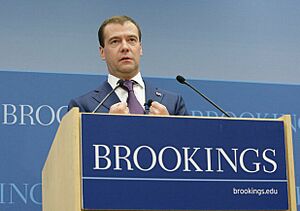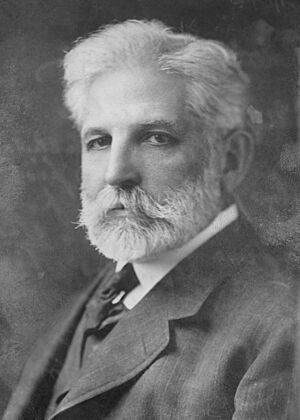Brookings Institution facts for kids

The Brookings Institution building near Dupont Circle in Washington, D.C.
|
|
| Abbreviation | Brookings |
|---|---|
| Formation | 1916 |
| Founder | Robert S. Brookings |
| Type | Public policy think tank |
| Headquarters | 1775 Massachusetts Avenue, N.W. |
| Location |
|
|
President
|
Cecilia Rouse |
|
Revenue (2023)
|
$89.4 million |
| Expenses (2023) | $98.8 million |
| Endowment | $538 million (2023) |
|
Formerly called
|
Institute for Government Research |
The Brookings Institution, often called Brookings, is an American think tank. A think tank is like a research center where experts study important topics and suggest ideas to help leaders make good decisions. Brookings focuses on subjects like economics, city planning, how governments work, and foreign policy (how countries deal with each other).
Brookings says its experts have many different ideas and that the organization is nonpartisan, meaning it doesn't favor one political party. News groups have described Brookings as centrist (in the middle), liberal, or center-left.
Since 2008, the University of Pennsylvania's Global Go To Think Tank Index Report has called Brookings the "Think Tank of the Year" and the "Top Think Tank in the World." It is still known as the most often mentioned think tank globally.
Contents
Exploring Brookings' History
How Brookings Began
Brookings started in 1916 as the Institute for Government Research (IGR). Its goal was to be the first private group to study national public policy issues. It officially began on March 13, 1916, and started working on October 1, 1916.
The main goal of Brookings is to offer smart and useful ideas. These ideas aim to make American democracy stronger, improve the lives and opportunities of all Americans, and help create a more open, safe, and cooperative world.
The founder, Robert S. Brookings (1850–1932), first created three separate groups. These were the Institute for Government Research, the Institute of Economics, and the Robert Brookings Graduate School. All three groups joined together to form the Brookings Institution on December 8, 1927.
Brookings During Big Events
During the Great Depression, a tough economic time, economists at Brookings studied why it happened. President Franklin D. Roosevelt asked them to do this. Later, Brookings' first president, Harold G. Moulton, and other scholars disagreed with Roosevelt's National Recovery Administration. They believed it was slowing down the economy's recovery.
When the U.S. entered World War II in 1941, Brookings researchers helped the government. They did studies on how to get the country ready for war. In 1948, Brookings was asked to create a plan for the European Recovery Program, also known as the Marshall Plan. Their plan helped make sure the Marshall Plan was managed carefully and efficiently.
In 1952, Robert Calkins became president. He got money from the Rockefeller Foundation and the Ford Foundation. He also reorganized Brookings into three main areas: Economic Studies, Government Studies, and Foreign Policy Programs. In 1957, Brookings moved to a new research center near Dupont Circle in Washington, D.C.
In 1967, Kermit Gordon became president. He started a series of studies in 1969 called "Setting National Priorities." These studies looked at different choices for the federal budget. He also made the Foreign Policy Studies Program bigger to include research on national security and defense.
After Richard Nixon became president in 1968, the relationship between Brookings and the White House became difficult. Despite this, Brookings received many government research contracts throughout the 1970s.
In 1976, Gilbert Y. Steiner became the fourth president. He brought in many experts whose research covered topics from government reform to city policies. This made the program more visible and important.
By the 1980s, Brookings faced more competition. A big focus of their research became how to reduce the federal budget deficit. They also studied problems with national security and government efficiency. Bruce MacLaury, the fifth president, started the Center for Public Policy Education. This center held workshops and public discussions to share research with more people.
A study from 1993 to 2002 found that politicians from both major parties often mentioned Brookings. This showed that Brookings was seen as a reliable source of information. The same study found that Brookings was the most often mentioned think tank by U.S. news and politicians.
In 1995, Michael Armacost became the sixth president. He worked to update Brookings' mission for the 21st century. Under his leadership, Brookings created new research centers. One was the Center on Urban and Metropolitan Policy, which focused on the strengths of cities. Another was the Center for Northeast Asian Policy Studies, which brought together experts from different Asian countries to study regional issues.
Brookings in the 21st Century


In 2002, Strobe Talbott became president. Soon after, Brookings started the Saban Center for Middle East Policy and the John L. Thornton China Center. In 2006, Brookings announced the Brookings-Tsinghua Center in Beijing, China. In 2007, they created the Engelberg Center for Health Care Reform and the Brookings Doha Center in Qatar.
In 2011, Talbott opened the Brookings India Office.
In October 2017, former general John R. Allen became the eighth president. He stepped down in June 2022.
As of June 30, 2019, Brookings had an endowment (money set aside for future use) of $377.2 million.
Brookings used to have three international centers: in Doha, Qatar; Beijing, China; and New Delhi, India. In 2020 and 2021, Brookings announced it was no longer directly connected to its centers in Doha and New Delhi. Its center in Beijing became an informal partnership with Tsinghua University.
How Brookings Influences Policy
Brookings has a long history, starting in 1916. It has helped create important organizations like the United Nations and the Congressional Budget Office. It also helped develop policies for deregulation (reducing government rules), tax reform, welfare reform, and foreign aid.
The annual think tank index by Foreign Policy magazine ranks Brookings as the top think tank in the U.S. The Global Go To Think Tank Index believes it is the number one such tank in the world. Even though news outlets mention think tanks less often now, Brookings' research is still the most frequently cited.
In a 1997 survey of people who work for Congress and journalists, Brookings was ranked as the most influential and trustworthy among 27 think tanks. Brookings and its researchers are more focused on strong academic research than on pushing a certain political idea. Along with the Council on Foreign Relations and Carnegie Endowment for International Peace, Brookings is seen as one of the most important policy groups in the U.S.
Brookings' Political Viewpoint
Brookings is a nonprofit organization that describes itself as independent and nonpartisan. A 2005 study found it to be "centrist" because both conservative and liberal politicians mentioned it almost equally in government records from 1993 to 2002. News organizations like The New York Times and The Washington Post have called Brookings liberal, liberal-centrist, centrist, or center-left. The Los Angeles Times called it liberal-leaning and centrist, saying that such labels might not truly capture its work.
In 1977, Time magazine called Brookings the "nation's pre-eminent liberal think tank." Newsweek has called it centrist, and Politico has used the term "center-left."
Brookings scholars have worked in both Republican and Democratic government administrations.
Brookings' board of trustees includes many leaders from business and industry, as well as political figures.
Leaders of Brookings
Since it became the Brookings Institution in 1927, it has been led by accomplished academics and public servants. Brookings has had eleven presidents, including some who served temporarily. The current president is Cecilia Rouse, who started in January 2024.
- Harold G. Moulton, 1927–1952
- Robert D. Calkins, 1952–1967
- Kermit Gordon, 1967–1976
- Gilbert Y. Steiner (acting), 1976–1977
- Bruce K. MacLaury, 1977–1995
- Michael Armacost, 1995–2002
- Strobe Talbott, 2002–2017
- John R. Allen, 2017–2022
- Ted Gayer (acting), 2022–2022
- Amy Liu (acting), 2022–2023
- Cecilia Rouse, 2024–Present
Brookings Staff and Their Union
The staff at Brookings formed a union called Brookings United in 2021. This union is part of the Nonprofit Professional Employees Union (NPEU). In 2024, the union and Brookings agreed on a new three-year contract.
Key Research Programs
Center for Middle East Policy
In 2002, Brookings started the Center for Middle East Policy (CMEP). Its goal is to help people better understand the choices American leaders face in the Middle East. The center began with a special speech by King Abdullah II bin al-Hussein of Jordan.
The center was originally named after American-Israeli film producer Haim Saban, who gave a large donation to help start it. Saban said he was involved because he wanted to help bring Arab-Israeli peace and protect American interests in the Middle East.
Some people have wondered if the money the center receives from different sources affects its research. However, the center has said that its donors respect its independence.
People at the Center
- Natan Sachs, Director and Fellow
- Daniel L. Byman, Senior Fellow
- Shadi Hamid, Senior Fellow
- Suzanne Maloney, Senior Fellow, and Vice President for Foreign Policy, Brookings
- Chris Meserole, Fellow
- Bruce Riedel, Senior Fellow
Brookings-Tsinghua Center for Public Policy
The Brookings-Tsinghua Center (BTC) for Public Policy started in 2006. It is a partnership between Brookings in Washington, D.C., and Tsinghua University in Beijing, China. The center aims to do research on important topics for China's development and for relations between the U.S. and China.
21st Century Defense Initiative

The 21st Century Defense Initiative (21CDI) focuses on research and analysis about the future of war, what the U.S. needs for defense, and the future of the U.S. defense system.
This initiative uses knowledge from other regional centers within Brookings, like the Center on the United States and Europe, and the Center for Northeast Asian Policy Studies. This helps them combine different types of knowledge.
P. W. Singer, who wrote Wired for War, is the Director of the 21st Century Defense Initiative. Michael O'Hanlon is the Director of Research.
WashU at Brookings
In the 1980s, the Center for Public Policy Education (CPPE) was created to hold workshops and public discussions. In 2005, it became the Brookings Center for Executive Education (BCEE), and later Brookings Executive Education (BEE). This led to a partnership with the Olin Business School at Washington University in St. Louis. This academic partnership is now known as "WashU at Brookings."
Important Centers at Brookings
- Center for Middle East Policy
- Center for Universal Education
- Urban-Brookings Tax Policy Center
Brookings Buildings
The main building of Brookings was built in 1959 at 1775 Massachusetts Avenue. In 2009, Brookings bought another building across the street. This building was a large house built in 1922 for the Ingalls family.
See also
 In Spanish: Institución Brookings para niños
In Spanish: Institución Brookings para niños
- List of think tanks in the United States


